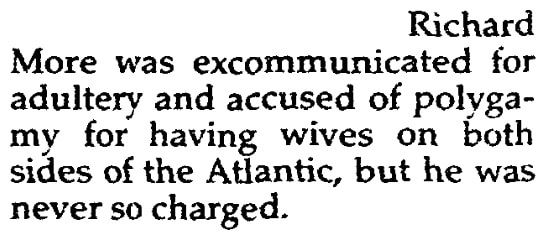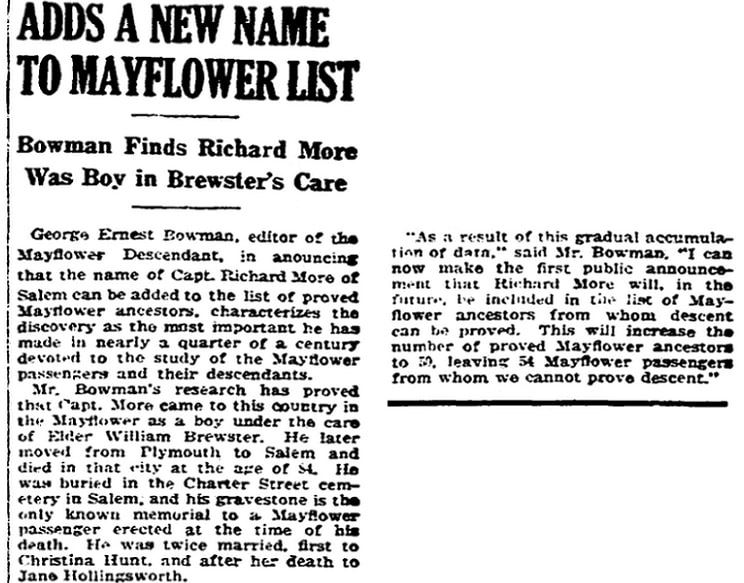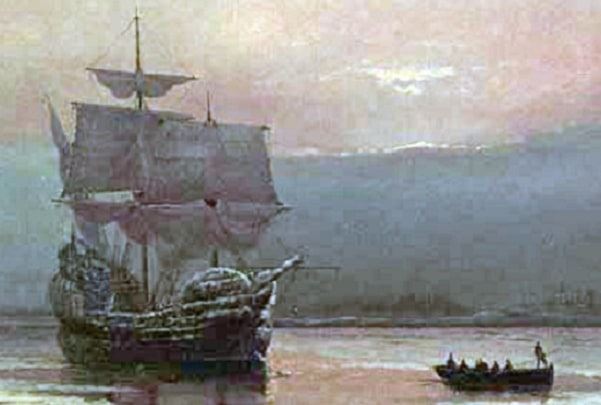Introduction: In this article – to celebrate November being the 400th anniversary of the arrival of the Mayflower – Melissa Davenport Berry writes about some more of the darker sides of the Mayflower passengers, this time focusing on Richard More. Melissa is a genealogist who has a blog, AnceStory Archives, and a Facebook group, New England Family Genealogy and History.
My last story covered Caleb Johnson’s research, which revealed the dark side of some Mayflower passengers. One of them was Richard More. A search in GenealogyBank’s Historical Newspaper Archives provides clues to Richard’s origins, involving his mother’s alleged adultery. The faux pas that went down between Richard’s parental units was perhaps a harbinger, as the apple does not fall far from the tree.

More was confirmed a Mayflower passenger in 1920 when George E. Bowman, founder of the Mayflower Society and editor of The Mayflower Descendant magazine, announced his research. This discovery was considered one of Bowman’s most important achievements, and newspapers across the country published his discovery.

Here is a synopsis from this Boston Herald article:
Captain Richard More of Salem, Massachusetts, came to this country on the Mayflower as a boy under the care of Elder William Brewster. He later moved to Salem and is buried in the Charter Street Cemetery. His gravestone is the only known memorial to a Mayflower passenger erected in that cemetery at the time of his death. He was twice married, first to Christina Hunt and then Jane Hollingsworth.
Although Richard made the cut “to the list of proved Mayflower ancestors,” there remained unanswered questions surrounding his identity. Plus, he was not the only More child to sail on the Mayflower; it was believed that the four More siblings onboard were paupers in the custody of London authorities sent as laborers to the New World, but that was far from the truth.
A story published in the San Francisco Chronicle spilled the secrets of the More children. The discoveries came from records in an ancient stone church and a 1622 document found in his attic in 1959 by a descendant of Samuel More (the disputed father of the four children), Sir Jasper More of Linley Hall.
The document Jasper found told the story: Samuel accused his wife Katherine (the mother of the four children) of adultery with a neighbor, Jacob Blakeway, who – Samuel insisted – was the real father of the children. Enraged, Samuel took the children away from Katherine and, without her knowledge or consent, banished them to the New World onboard the Mayflower.
Six-year-old Richard had crossed the Atlantic onboard the Mayflower with his three siblings, Elinor, Jasper, and Mary, who were placed in the care of Plymouth’s finest: William Brewster, Jasper John Carver, and Edward Winslow. Only Richard survived, the other three perishing within months of arrival. There is a Mayflower plaque in St. James Church in Shipton, Shropshire, England, commemorating the More children, and a website Shropshire’s Mayflower Children.
Through church records, the identity of Richard More’s parents became known: Samuel and Katherine More, who married at the Shipton Church on 9 February 1610. It is purported the marriage was a merger to combine land holdings. The children’s baptisms are listed in the records as well.
In the document Jasper found in his attic, his ancestor Samuel had spilled a real shocker. He wrote that he learned “of the common fame of the adulterous life” of his wife and Jacob Blakeway, a “fellow of mean parentage and condition.” Samuel told the courts that his children and Blakeway are “alike in visages and lineaments.”
Although Samuel sent the children to the New World, he did at least make provisions of 80 pounds to provide for necessary needs, and another 20 pounds in “adventure money” with any profits to be given to the children.
The More family are royal descendants, traced back to King Edward III. Next up: Richard More in Salem, Massachusetts, with more scandal.
Related Articles:
